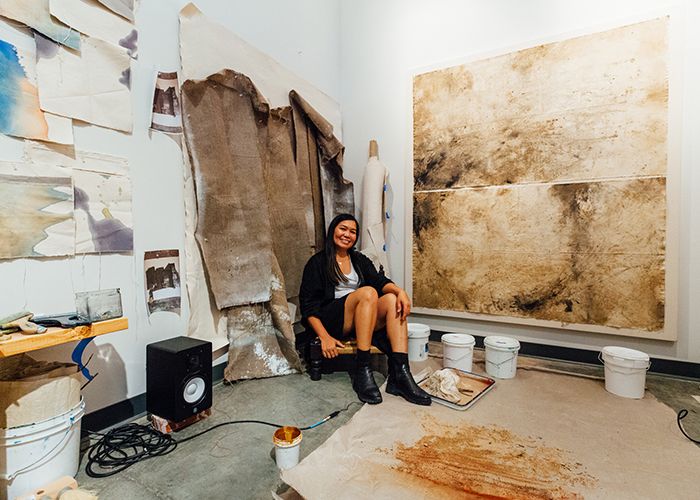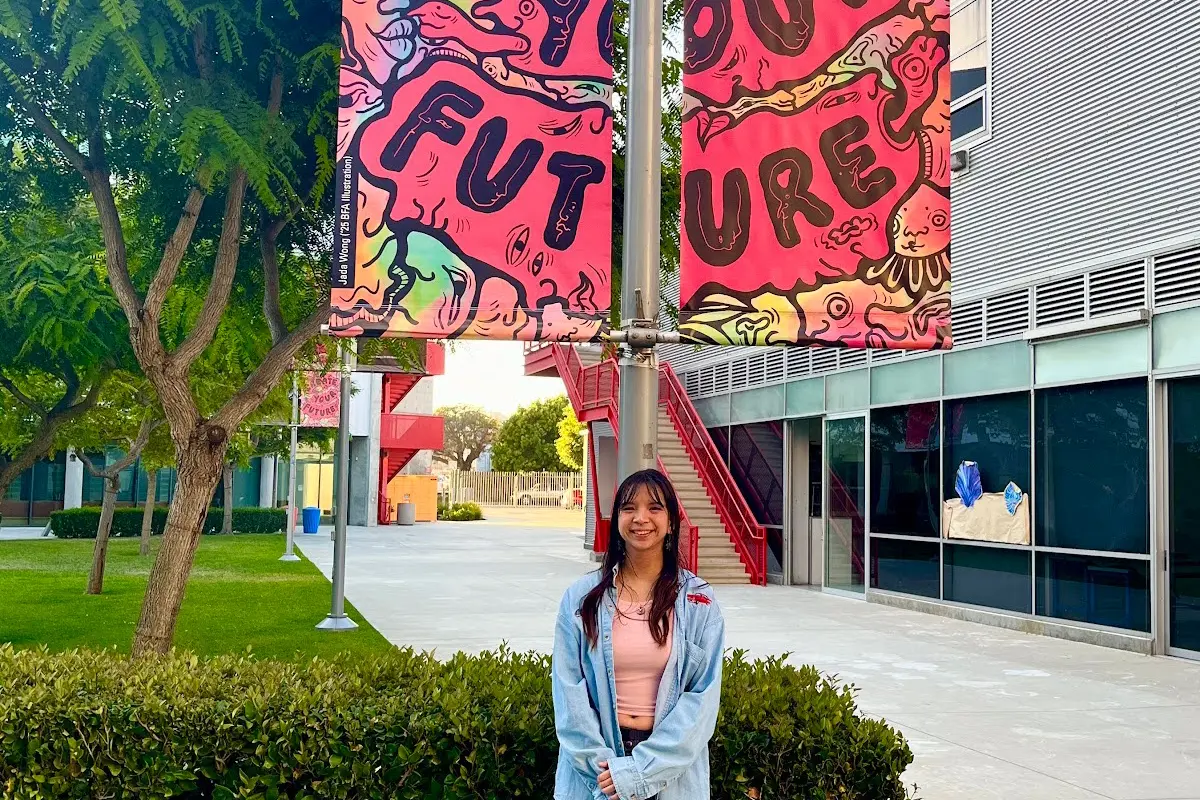The United Artist Project at Otis College Brings the MFA Fine Arts Program to Westchester
Reuniting the graduate and undergraduate Fine Arts programs under one roof after decades apart brings endless synergy among students and faculty.
By Matt Stromberg 
Like the proverbial blank canvas, Otis College’s new MFA studios started out this summer as a series of stark white walls in the Bronya and Andy Galef Center for Fine Art. However, shortly after the MFA candidates moved into their individual studio spaces—four-sided boxes each measuring roughly 125 square feet, with open ceilings—they had become vivid reflections of the creative vision and personalities of their inhabitants. In addition to the works-in-progress splayed across the walls or even the floors, the studios now also house desks, armchairs (one spray-painted in colorful flowers), twinkle lights, bookcases, and even mini refrigerators.
The presence of the MFA Fine Arts program on Otis’s Elaine and Bram Goldsmith campus in Westchester marks the first time graduate and undergraduate Fine Arts students have been united on the same campus in decades. Since 2013, the MFA program had been located in Culver City, several miles away, and before that the studios were in El Segundo. The recent move makes it the last program to join the rest of the College, following Fashion Design, which moved in 2016 from its former site in the Fashion District downtown to a brand-new academic building, now named after designer Anne Cole.
“After much discussion, we concluded that there are many benefits in moving the program to our main campus,” says Provost Jiseon Lee Isbara. “The most important benefit would be the direct location for MFA students to access our diverse faculty and student body, multimedia facilities, and versatile programs.”
Dubbed the “United Artist Project,” the initiative allows MFA students to access their studios 24-hours a day, seven days a week, and also brings them within steps of the Galef Center’s lighting, ceramics, and sculpture studios, as well as the campus’s labs and shops, including the wood and metal shop, printmaking lab, Lab Press, A/V lab, photo lab, Millard Sheets Library, computer labs, and spaces where such undergraduate programs as Product Design, Digital Media, Communication Arts, and Toy Design are housed.
“We’ve always wanted to build a stronger combined community,” says Meg Cranston, Chair of both BFA and MFA Fine Arts programs. “When the College suggested bringing the MFAs onto campus we were excited about the possibility.”
When Otis was founded in 1918 it was housed in the Bivouac, a Mission Revival mansion in MacArthur Park donated by General Harrison Gray Otis to be used “continuously and perpetually for the arts.” As the College expanded to BFA and MFA programs in the 1950s, the Bivouac was replaced by new studios and a gallery, still located in MacArthur Park (and now the site of the Charles White Elementary Visual Arts Magnet, named after famed Otis instructor Charles White). The big move to Westchester came in 1997, and with it, the separation of programs, as the main campus moved to a former IBM headquarters in Westchester (now Ahmanson Hall), Fashion Design moved downtown, and MFA Fine Arts relocated to El Segundo.
“It’s more convenient to be where the materials and support are,” Cranston says of the new move to the Goldsmith campus. “ We had a small woodshop at Culver City, but if you have to drive a couple of miles to cut a piece of wood, maybe you’ll make a drawing,” she adds, half-jokingly.
Her point was echoed by Kade L. Twist, the MFA Fine Arts’ curriculum area head of Art + Social Practice. “It will invite students who work at larger scales to commit to Otis,” he says. “In the past, we had sculptors who made a different decision based on that challenge.”
Cranston frames this benefit in terms of a renewed focus on material production. “Against the background of digital media, skills-based learning has had a renaissance that is not different from critical education. It’s part of it,” she stresses.
MFA students will also be in closer proximity to a greater pool of faculty. “In this era, having silos really prevents departments from functioning more strategically and efficiently,” Twist says. “Otis has so many resources, and so many talented, brilliant people that our graduate students should have better access to.”
In addition to access to facilities and faculty, the move will bring graduate and undergraduate students together, with benefits for both groups. This process began even before the physical move, with the cross-listing of courses, making it easier for students to take classes outside of their program. “It was already possible, but it was cumbersome,” says Kathrin Burmester, Director of the MFA Fine Arts program. “Because the students asked for it, we saw that it made sense to expand the curriculum in that way.”
“We tested this for two years prior, making it easier for BFAs to petition to enroll in graduate courses, and vice versa. That really took off,” Cranston adds.
“The synergy that our BFA and MFA Fine Arts students can create by being in the same studio spaces and actively exchanging ideas will be endless.”
With the whole student body on the same campus, those connections formed in the classroom can extend to studio spaces and life outside the classroom as well. “As our Educational Vision Statement says, ‘Diversity is a critical engine for creativity and collective achievement’ as well as collaboration,” Lee Isbara says. “Our BFA and MFA students already share elective courses and opportunities that our prominent Fine Arts faculty and visiting artists offer. The synergy that our students can create by being in the same studio spaces and actively exchanging ideas will be endless.”
This special synergy is something Otis alumnx felt was integral to their education. Vincent Ramos (’02 BFA Fine Arts) recalled having a graduate teacher’s assistant mention artists he should look at who then brought him their monographs the following week. Being able to take graduate classes offered him further insights. “There was another layer with graduate students. Being in classes with them, it was good to see their work, how much more refined it was and more advanced in terms of their thinking,” he says. “Art school in general is about, ‘Let’s see what someone else is doing in their studio.’ Now that [the two programs are] together, there will be more of that.”
Alison Saar (’81 MFA Fine Arts), who attended Otis when it was still in MacArthur Park, mentions the special bond between students that came from their physical juxtaposition. “Our studios were just a derelict building without walls, but there was camaraderie between us. We were sitting in each other's laps,” she notes.
Saar, whose multidisciplinary practice encompasses sculpture, painting, and installation, also noted the narrow-minded view that Otis’s new approach is working to change. “People aren’t just painters,” she says. “There’s a false compartmentalizing of materials and techniques.

The Bronya and Andy Galef Center for Fine Arts at Otis College houses the new MFA Studios.
With the move of its MFA Fine Arts students to Westchester, Otis completes a journey that began a century ago in a donated mansion off MacArthur Park. The College’s strength as an art and design school comes not only from its faculty and resources, but from its students, who benefit when they can learn from each other.
“If you expose the students that are part of the institution to one another, you create an environment where everyone learns something about everyone else’s journeys,” Burmester says. “It’s all part of an education and getting an understanding about what kind of community you’re a part of, with different voices across departments, including faculty, staff, and students. Rather than being in a silo far away, there’s so much more potential for growth in this process of education."








